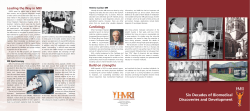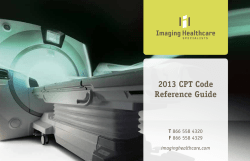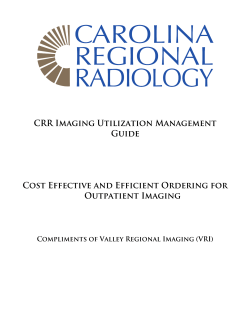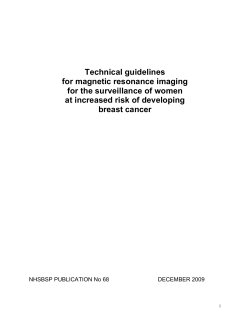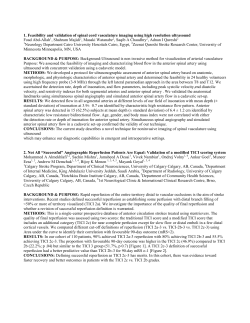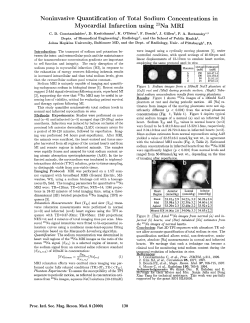
Document 9671
The Danish National Research Foundation’s Center of Functionally Integrative Neuroscience Aarhus University / Aarhus University Hospital - DENMARK Imaging of Transient Ischemic Attack and Stroke Leif Østergaard MD, MSc, PhD, DMSc, Director, Professor Center of Functionally Integrative Neuroscience Department of Neuroradiology Århus University Hospital Overview • MRI Techniques Detecting hemorrhagic strokes: T2* MRI Detecting acute ischemic lesions: Diffusion MRI Detecting tissue at risk of infarction: Perfusion MRI • Predicting patient outcome Predicting stroke after TIA Predicting infarct growth in acute stroke • The use of MRI in acute stroke management Is it feasible? Does it make a difference to our patients? Is it cost-effective? • Current Research: Overcoming knowledge barriers Turning large databases into clinical decisions and better care The Danish National Research Foundation’s Center of Functionally Integrative Neuroscience Aarhus University / Aarhus University Hospital Imaging TIA – and Stroke Diffusion MRI detects early ischmic lesions 11 min pre-stroke 11 min post-stroke 3h post-stroke 24 h post-stroke 78 year old female imaged 2 hours after brief TIA episode. Treated with rtPA Hjort et al. Ann Neurol. (2005) Acute MRA The Danish National Research Foundation’s Center of Functionally Integrative Neuroscience Aarhus University / Aarhus University Hospital Acute MTT Ischemic stroke: Who to treat with rtPA? Infarct growth from 5 hours to 5 days ICH post rtPA The Danish National Research Foundation’s Center of Functionally Integrative Neuroscience Aarhus University / Aarhus University Hospital Who to treat? How to predict infarct growth? Normal autoregulation DWI lesion Percent Change Tissue Death 64 y.o. female 5.5 hours after onset of L leg weakness ACA territory MTT MTT 1994 Adapted from Powers Powers et al. (1994) The Danish National Research Foundation’s Center of Functionally Integrative Neuroscience Aarhus University / Aarhus University Hospital CBF CBV Diffusion - Perfusion Mismatch highlights tissue at risk. ≥ 90 % risk of Infarct growth Mismatch T2 DWI Sorensen et al Radiology 1999 The Danish National Research Foundation’s Center of Functionally Integrative Neuroscience Aarhus University / Aarhus University Hospital rMTT 5-day followup DWI 78 y.o. F 3 hours after onset of aphasia Mismatch prevalence Beyond 3 hours: MRI Tissue Clock Darby et al Stroke. 30:2043-52 (1999) Acute – before tPA At risk NIHSSS = 14 M1 MCA occlusion 2 hours post tPA MTT DWI T2 after 3 months NIHSS = 0 MRS = 0 NIHSSS = 3 Niels Hjort, Christine Sølling, Mahmoud Ashkanian The Danish National Research Foundation’s Center of Functionally Integrative Neuroscience Aarhus University / Aarhus University Hospital 62 year old female with acute left hemisensory stroke is treated by rtPA Acute DWI The Danish National Research Foundation’s Center of Functionally Integrative Neuroscience Aarhus University / Aarhus University Hospital DWI 2 hours after rtPA DWI 24 hours after rtPA • • TIA patients: 35% have DWI lesions, 33% have PWI lesions; 16% both Combined 51%; mostly in ’culprit’ hemisphere Mlynash et al. Neurology. 2008 Dec 17. [Epub ahead of print] The Danish National Research Foundation’s Center of Functionally Integrative Neuroscience Aarhus University / Aarhus University Hospital Predicting stroke after TIA • ABCD2 and DWI (N=601/25) Adding MRI and clinical data increases AUC from 66% to 81% in predicting stroke/no stroke within 1 week Ay et al. Stroke. 2009;40:181-6 • ABCD2 DWI, LAA and AF (N=343/5/10) Hazard ratios • • • • ABCD(2) > 5: 10.1 DWI: 8.7 LAA 3.4 AF N.S. Calvet et al. Stroke. 2009;40:187-92 The Danish National Research Foundation’s Center of Functionally Integrative Neuroscience Aarhus University / Aarhus University Hospital Does advanced MRI work in real life??? The Danish National Research Foundation’s Center of Functionally Integrative Neuroscience Aarhus University / Aarhus University Hospital Study design h År us n De Area with 600 000 inhabitants k ar m New center – rtPA from April 2004 MR-project in daytime, weekdays - Otherwise CT Prospective rtPA database from 2004-2006 Data: • Demographics • Time data • Imaging data • Outcome data Implementation of: • Stroke code. Fast track • Stroke admission room • Stroke MRI training The Danish National Research Foundation’s Center of Functionally Integrative Neuroscience Aarhus University / Aarhus University Hospital Study design Onset-Needle-Time (ONT) : Max 3h Door-to-Needle-Time (DNT) : Goal 60 min Decision time Onset-Door Assessment Clinical criteria: 18-80 years NIHSS 1-25 NINDS criteria The Danish National Research Foundation’s Center of Functionally Integrative Neuroscience Aarhus University / Aarhus University Hospital MRI Imaging criteria No ICH (T2*) Ischemic lesion (DWI, PWI) Needle-Time rtPA 0.9 mg/kg • • • • • Århus Study 2004-2006 174 Referred 142 MRI 73 ischemic infarcts 40 received iv-rtPA (95 treated per mio.) Why did 32 patients not undergo MRI? 13 not indicated 4 metal implants (pacemaker, Hoffman's app) 7 anatomy (weight, positioning) 4 unstable clinical condition 2 patient consent (claustrophobia) 2 technical problems The Danish National Research Foundation’s Center of Functionally Integrative Neuroscience Aarhus University / Aarhus University Hospital 10.5 % Results – Time data MRI did not delay treatment compared to CT MR n=40 CT n=17 68,5 64 69 NIHSS 10 9 12 "Onset-door-time" 82 105 65 "Door-imaging-time" 26 30 25 "Imaging" 25 10 5 "Onset-Imaging-report" 140 140 "Decision-time" 13 24 DNT "Door-to-needle" 70 66 68 ONT "Onset-to-needle" 157 160 145 Age Sølling et al. Acta Neurol Scand. 2008 Dec 29. The Danish National Research Foundation’s Center of Functionally Integrative Neuroscience Aarhus University / Aarhus University Hospital SITS-MOST* n=6483 * Wahlgren, The Lancet, 2007 Decision making We treated 40 patients: MRI potentially influenced decisionmaking in 24 referred patients: In favour of rtPA 2 patients thrombolysed despite seizures • 9 patients with NIHSS < 5 (DWI +/- mismatch) • Often excluded in CT based studies Against rtPA • 6 patients with large infarctions (but NIHSS within limit < 25) • 7 patients with NIHSS > 4 had no DWI lesions (stroke mimics!) Sølling et al. Acta Neurol Scand. 2008 Dec 29. The Danish National Research Foundation’s Center of Functionally Integrative Neuroscience Aarhus University / Aarhus University Hospital All Mild 0,0 Moderate Severe NIHSS>15 NIHSS 8-15 mRS 0-2: for NIHSS >14 0,4 0,6 0,5 Saver, Stroke, 2007 0,0 The Danish National Research Foundation’s Center of Functionally Integrative Neuroscience Aarhus University / Aarhus University Hospital NINDS tPA Sølling et al Cerebrovasc Dis. 2009;27:223-229. Århus CT 0,1 Århus MR 0,2 Århus all 0,3 0,4 0,3 0,2 0,1 0,0 Århus all 0,5 NINDS placebo mRS 0-1: for NIHSS 8-14 NINDS placebo 0,0 NINDS placebo mRS 0: for NIHSS <8 0,1 NINDS tPA 0,1 NINDS tPA ‘Good outcome’: 0,2 Århus CT 0,2 Århus MR (sliding dichotomy) Århus CT 0,3 NINDS placebo 0,3 NINDS tPA 0,4 Århus CT 0,4 Århus MR 0,5 Århus MR NIHSS<8 0,5 Århus all Outcome within severity subgroups All Århus all Outcome Does acute imaging only help those who get rtPA? • Prospective registration of 800 “stroke mimics” at our stroke unit Stage I: Before implementation of tPA Stage II: During implementation (MR-project) Stage III: After full implementation • Data Baseline clinical data (age, gender, neurological signs (SSS)) Time data (admission, imaging, discharge) Discharge-diagnoses (ICD-10 codes) • Analysis: Predictors for Length-of-Stay (LOS) • Estimate of economic implications Sølling et al. Cerebrovasc Dis. 2009;27:60-6. The Danish National Research Foundation’s Center of Functionally Integrative Neuroscience Aarhus University / Aarhus University Hospital III Results Stage I : Before tPA Stage II: During MR-project Stage III: After full implementation of tPA Stage III: LOS significantly reduced after implementation of tPA Sølling et al. Cerebrovasc Dis. 2009;27:60-6. The Danish National Research Foundation’s Center of Functionally Integrative Neuroscience Aarhus University / Aarhus University Hospital Acute referral organization with MRI Acute stroke organization Immediate imaging Fast diagnostic evaluation Faster discharges (50% LOS reduction) – related to acute MRI Thrombolysis is cost-effective*. In addition, improved management of non-stroke patients may also contributes to the cost-effectiveness of tPA treatment (estimated 30% cost reduction) Sølling et al. Cerebrovasc Dis. 2009;27:60-6. The Danish National Research Foundation’s Center of Functionally Integrative Neuroscience Aarhus University / Aarhus University Hospital *Ehlers, Stroke, 2007 Flaskehalsen: For mange data 1400 images 2 minutes Experience from 1000 patients 1 million neurons die every minute! The Danish National Research Foundation’s Center of Functionally Integrative Neuroscience Aarhus University / Aarhus University Hospital Niels Hjort, Christine Sølling, Mahmoud Ashkanian Stroke prediction model based on expertclassified database: Joint EU project I-Know • Model based on expert-classified database (120 patients) • Model seeks to separate final outcome (infarct/salvaged) in Ndimensional space (voxel-by-voxel image intensity and available clinical/treatment data) across all patients • Resulting model yields infarct risk map in ’unknown’ patient based on acute image and clinical data. Østergaard et al Current Opinions Neurol 2009 The Danish National Research Foundation’s Center of Functionally Integrative Neuroscience Aarhus University / Aarhus University Hospital Diagnostic Support System Expert diagnosis based on database - Everywhere Århus University Hospital 111111-1112 John Doe Infarct Risk 100% Risik factors Diabetes Hypertension Based on 120 patients 30% EPR The Danish National Research Foundation’s Center of Functionally Integrative Neuroscience Aarhus University / Aarhus University Hospital Latest Current beta-version • • • • • The Danish National Research Foundation’s Center of Functionally Integrative Neuroscience Aarhus University / Aarhus University Hospital Automated data analysis Mismatch segmentation Volume calculations Best-case prediction: Reperfusion (N=32) Worst-case prediction No reperfusion (N=29) Take-home: Overview • MRI Techniques Detecting hemorrhagic strokes: T2* MRI Detecting acute ischemic lesions: Diffusion MRI Detecting tissue at risk of infarction: Perfusion MRI • Predicting patient outcome Predicting stroke after TIA MRI and clinical data Predicting infarct growth in acute stroke MRI (and CT) • The use of MRI in acute stroke management Is it feasible? Yes – and as fast as conventional CT! Does it make a difference to our patients? Yes – better selection! Is it cost-effective? Yes! • Current Research: Overcoming knowledge barriers Turning large databases into clinical decisions and better care Clinical Decision Support Systems may help advanced decentralized treatment The Danish National Research Foundation’s Center of Functionally Integrative Neuroscience Aarhus University / Aarhus University Hospital I-Know Partners Contact: www.i-know-stroke.eu The Danish National Research Foundation’s Center of Functionally Integrative Neuroscience Aarhus University / Aarhus University Hospital Leif Østergaard, MD, PhD, MSc, DMSc Professor, I-Know Project Coordinator Aarhus University Hospital - DENMARK leif@cfin.dk Diffusion Weighted Imaging Changes in Ischemia Cat br ain - MCA occlusion Hindrance Restriction Barriers ATP-depletion Na+-K+ pump Cytotoxic edema Increased extracellular tortuosity Hindrance of water movement ADC decreases (0-5 days) = bright DWI The Danish National Research Foundation’s Center of Functionally Integrative Neuroscience Aarhus University / Aarhus University Hospital Moseley M.E , et al. 1990 Apparent Diffusion Coefficient (ADC) • Vary diffusion weighting b: S=exp (-bADC) Important w. ‘T2-shine through’ How old is the lesion? • Cytotoxic edema (5-6d) • Vasogenic edema (> 7 days) b Dw- MRI S ADC map ADC b The Danish National Research Foundation’s Center of Functionally Integrative Neuroscience Aarhus University / Aarhus University Hospital Courtesy Drs Bihan, Oppenheim Results - Outcome • 83 tPA after MRI • 27 tPA after CT • Symptomatic hemorrhages (<2%) Theoretical risk: 5- 8%, SITS-MOST: 2 % • Asymptomatic hemorrhages 20% Found at follow up • Mortality within 3 months (6,3%) SITS-MOST: 15% The Danish National Research Foundation’s Center of Functionally Integrative Neuroscience Aarhus University / Aarhus University Hospital Continous efforts reduces DNT Aarhus Denmark The Danish National Research Foundation’s Center of Functionally Integrative Neuroscience Aarhus University / Aarhus University Hospital Ruling out ICH by MRI 47 y.o. male, known HT: MRI after 5½ hours • T2* DWI DWI ’rim’ phenomenon, signal loss on T2* The Hemorrhage and Early MRI Evaluation (HEME) study. MRI < 6 h after onset. MRI: 1.5 T, T2* GRE, DWI b=0 and b=1000. Kidwell, JAMA 2004 The Danish National Research Foundation’s Center of Functionally Integrative Neuroscience Aarhus University / Aarhus University Hospital T2*
© Copyright 2025




